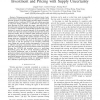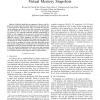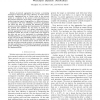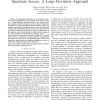INFOCOM
2010
IEEE
13 years 10 months ago
2010
IEEE
Abstract—This paper presents the first analytical study of optimal investment and pricing decisions of a cognitive mobile virtual network operator (C-MVNO) under spectrum supply...
INFOCOM
2010
IEEE
13 years 10 months ago
2010
IEEE
—This paper introduces a self-organized mechanism to control user access in ad hoc networks without requiring any infrastructure or a central administration entity. The proposed ...
INFOCOM
2010
IEEE
13 years 10 months ago
2010
IEEE
—Upon the occurrence of a phenomenon of interest in a wireless sensor network, multiple sensors may be activated, leading to data implosion and redundancy. Data aggregation and/o...
INFOCOM
2010
IEEE
13 years 10 months ago
2010
IEEE
Abstract—Malicious shellcodes are segments of binary code disguised as normal input data. Such shellcodes can be injected into a target process’s virtual memory. They overwrite...
INFOCOM
2010
IEEE
13 years 10 months ago
2010
IEEE
INFOCOM
2010
IEEE
13 years 10 months ago
2010
IEEE
—In-network aggregation has become a promising technique for improving the energy efficiency of wireless sensor networks. Aggregating data at various nodes in the network result...
INFOCOM
2010
IEEE
13 years 10 months ago
2010
IEEE
Abstract—The queueing performance of a (secondary) cognitive user is investigated for a hierarchical network where there are N independent and identical primary users. Each prima...
INFOCOM
2010
IEEE
13 years 10 months ago
2010
IEEE
—This paper formally establishes that random access scheduling schemes, and, more specifically CSMA-CA, yields exceptionally good performance in the context of wireless multihop...
INFOCOM
2010
IEEE
13 years 10 months ago
2010
IEEE
—Generating a secret key between two parties by extracting the shared randomness in the wireless fading channel is an emerging area of research. Previous works focus mainly on si...
INFOCOM
2010
IEEE
13 years 10 months ago
2010
IEEE
—The scalability limitations of BGP have been a major concern in the networking community lately. An important issue in this respect is the rate of routing updates (churn) that B...




